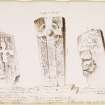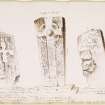Crieff, High Street, Burgh Cross
Cross Slab (Early Medieval)
Site Name Crieff, High Street, Burgh Cross
Classification Cross Slab (Early Medieval)
Alternative Name(s) Crieff, East High Street, Cross Slab; The Cross Of Crieff
Canmore ID 25495
Site Number NN82SE 7
NGR NN 86558 21563
Datum OSGB36 - NGR
Permalink http://canmore.org.uk/site/25495
- Council Perth And Kinross
- Parish Crieff
- Former Region Tayside
- Former District Perth And Kinross
- Former County Perthshire
Crieff, Perthshire, Pictish inscribed cross-slab
Measurements: H 2.70m, W 0.60m, D 0.14m
Stone type: sandstone
Place of discovery: NN 8655 2156
Present location: Crieff Tourist Information Centre.
Evidence for discovery: drawn by James Skene around 1830 in a stone base in the High Street, whence it had been brought sometime in the previous three decades probably from the Strowan area south-west of Crieff (Hall et al, 168-76). It was moved into the Information Centre in 1998.
Present condition: extremely worn and most of the carving on face C has been deliberately removed.
Description
This is a slightly tapered rectangular slab with a shaped basal tenon. It is carved in relief on all four faces, apart from the tenon, and roll mouldings define the edges and the cross. Face A bears a long-shafted cross with a ringed head, which is in higher relief than its background, with a central boss that is even higher and armpits that sink back lower than than the background carving. The central boss is carved with three spirals and the arms contain interlace linked around the boss. The ring bears step patterns and there are variants of key pattern in the spaces above the side arms. The shaft of the cross is divided into at least three panels, the top panel containing diagonal key pattern, the next panel bearing traces of an inscription, and the lower panel containing spirals. The inscription appears to have been arranged in four to six lines of miniscule letters and may have been deliberately defaced. To the left of the shaft, interlace with a median incised line merges towards the base with vine-scroll, while to the right there is similar interlace above a panel of diagonal key pattern. Face B bears an upper panel of diagonal key pattern and a lower panel of vine-scroll. Of the defaced face C only the base of the slab retains traces of carving in the form of two decorative borders, the outer containing interlace and the inner carved with diagonal key pattern. Face D bears two panels of zoomorphic vine-scroll above a basal panel of diagonal key pattern.
Date: ninth century.
References: Skene 1832, 10-11; Hall et al 2000.
Compiled by A Ritchie 2016
NN82SE 7 86558 21563
(NN 8655 2156) Cross (NR)
OS 25" map (1866)
Said to have come from the neighbouring farm of Trowan (NN 8221).
NSA 1845 (W Laing)
This is an upright cross-slab of sandstone 6 feet 3ins high, 1 foot 10 ins wide at top but 2 feet wide at base and 6ins thick. The sculpture on the back is defaced.
J R Allen and J Anderson 1903
This cross-slab, as described above, stands on the pavement on the north side of the High Street. It is in very good condition and well protected by a canopy and enclosing railing. There is a plaque which states:- "The Burgh Cross of Crieff. This cross-slab of celtic design (circa 10th century) was originally associated with an early ecclesiastical site". Visited by OS (WDJ) 21 March 1963
(Formerly scheduled as Crieff, cross slab, East High Street). Descheduled.
Information from Historic Scotland, Certificate of Exclusion from Schedule dated 9 October 2001.
Field Visit (25 September 1996)
This cross-slab is still in position, as is the plaque described by the OS in 1963.
Visited by RCAHMS (SDB) 25 September 1996


































































































